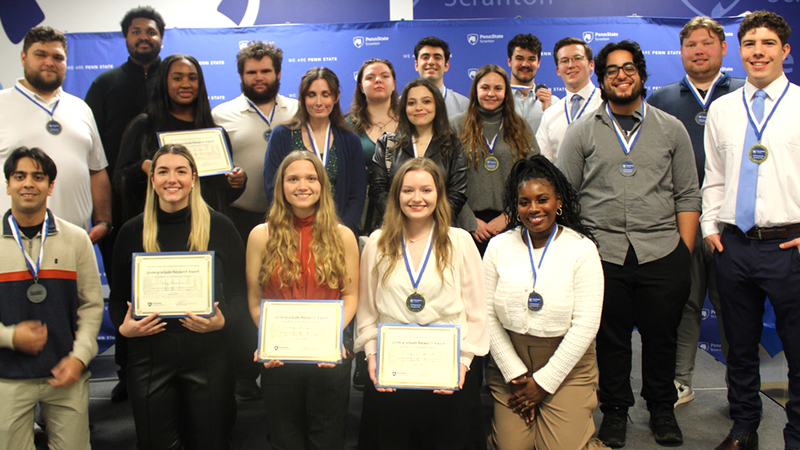

This dialog contains the full navigation menu for this site.

DUNMORE, Pa. – Penn State Scranton recently hosted its highly anticipated annual Undergraduate Research Fair and Exhibition, drawing over 140 students from diverse disciplines and degree programs eager to showcase their undergraduate research, scholarship, and creative achievements. The event, a cornerstone of academic inquiry on campus, featured a vibrant array of projects ranging from poster presentations to oral discussions and visual arts displays.
Assistant Teaching Professor of Physics and Chair of the campus’ Research Committee Mario Freamat emphasized the significance of research in academia.
“Research is in the DNA of academia. That is, at the roots of modern universities is the endeavor to observe, model, and experiment on physical and societal phenomena, to share the results, and to entrust the knowledge and the communing mindset associated with these scientific activities to the new generation,” he said. “In this spirit, it is our duty to our students to involve them in research."
As the first time being in this position, Freamat said there was a lot to learn and he is thankful for the opportunity to be part of the team that organized the event.
“As the 2024 edition of the Undergraduate Research Fair and Exhibition is now part of the history of our campus, we can emphasize once again the importance of these events to bring the campus together in celebration of the excellent work of our students and their mentors,” Freamat said.
“I was happy to contribute since it made me professionally proud as a faculty member to observe and serve the mechanisms of knowledge production and sharing. On the other hand, being a cog wheel in the clockwork of the event allowed me to peek into and appreciate the amazing work done by our staff members, to whom I am so grateful. I am looking forward to the 2025 edition of the fair with quite a few new ideas to implement, inspired by the feedback we received.”
Student participants in the fair were evaluated across various categories including poster projects, creative writing, oral presentations, and visual arts. A photo album of the oral presentations, creative works and students with their research posters, as well as the winners, is available for viewing and free downloads on Penn State Scranton's Flickr account:
The Undergraduate Research subcommittee announced award winners for poster projects in each category and oral presentations, as well as the University Libraries Literacy Awards.
Empirical Category
Literature Review
Proposal
Design
Visual Arts
Oral Presentations
Kristin Green, associate librarian, reference and instruction, expressed admiration for the students' scholarly endeavors.
“It was very inspiring to hear the analyses in the oral presentations, see the scholarship in the poster presentations, and feel the imagination in the art exhibition,” she said. “All the library judges were impressed with the academic rigor and thoughtfulness that went into the research projects this year. It always fills me with pride to see our students showcase their scholarly and creative accomplishments at the fair."
The following students received the University Libraries’ Undergraduate Research Awards in Excellence in Information Literacy awards, for recognizing their outstanding achievements in research and scholarship:
Oral Presentations
Poster Presentations
In a testament to the quality of research at Penn State Scranton, the campus is proudly sending eight posters to represent the Scranton campus at the upcoming Regional Undergraduate Research Symposium hosted at Penn State Lehigh Valley Campus on April 20. This symposium, a collaborative effort among the eight eastern Penn State campuses, provides a platform for students to present their scholarly research across a spectrum of disciplines.
The symposium, structured into four categories including Arts and Humanities, Biological Sciences and Health, Physical Sciences, Information Sciences, and Engineering, and Social Sciences and Business, offers an opportunity for campuses to showcase their best projects.
The following students from Penn State Scranton are participating at Penn State Eastern Regional Undergraduate Research Symposium at Penn State York on Saturday, April 22:
Arts & Humanities
Biological Sciences and Health
Physical Sciences, Informational Sciences, and Engineering
Social Sciences and Business
By River Moon
In 2019, Penn State Scranton’s Undergraduate Research Fair entered into new territory when it was decided to include oral presentations for humanities majors.
Thanks to the support and work by the campus’ English faculty members, particularly Assistant Teaching Professor of English Kara Stone and Associate Professor of English Kelley Wagers, the oral presentations component gave humanities majors an opportunity to share their research as a verbal presentation, as opposed to a research poster.
Participating in the fair this way is a similar to how English faculty present their research at professional conferences. The students’ projects are presented, either with or without a PowerPoint, and the audience is given time to ask questions and have a discussion.
A few years later, thanks to the involvement of Lecturer in Art/Art Honors Program Coordinator Corianne Thompson, art also became part of the event, featuring paintings, drawings, and sculptures.
That is when the annual event became known as the Undergraduate Research Fair and Exhibition.
A majority of 400-level English classes require students to complete a research project, and faculty always encourage their students to participate in the fair by presenting their projects. Stone acts as an advisor and proctor for students presenting their research.
“Having a venue to showcase this research and engage in academic discourse with other students is very important,” said Stone. “That is why I am so passionate about the oral presentation portion of the fair because I am so proud of the work that undergraduate students are doing each semester.”
Multiple English faculties also serve as judges of the oral presentations. Some of this year’s judges include Assistant Teaching Professor Paul Perrone, who also serves as program coordinator for English and Multidisciplinary Studies, and Associate Professor of English Eva Tettenborn, both of whom choose to judge the presentations in support of their students.
Perrone chooses to judge because he, “wanted to consider presentations in a more than superficial way because the subject matter is in the lifeline of my discipline.”
Additionally, Tettenborn said she judges because, “Each year, I am astonished and humbled by the quality of research produced by our English majors, many of whom present in ways that would be appropriate at professional conferences faculty members attend. It is a joy to watch our students at work!”
When judging, Perrone and Tettenborn must consider certain aspects of student presentations and compare them to a rubric in order to judge equitably. Important things they look for are originality and thought process, correct citations that are well-integrated in the presentation, correctly following academic integrity guidelines, and how well the student is able to orally communicate and engage with the audience.
Research is important for English professors and majors because it further develops their analytical and critical thinking skills, as well as communication skills and gives them a great way to showcase these skills.
For Assistant Teaching Professor of English Jody Griffith, research is important because, “it allows me to read more deeply and satisfy my curiosity about questions that come up as I read. I want to know what historical context and social assumptions might inform the text I’m reading, and what other readers have had to say about it. I also think it’s important because research allows texts to continue to live and have meaning for each new generation of readers.”
Her own professional research is focused on literature and novels of 19th-century England. “I like paying attention to how a story is put together and how it makes meaning. I’m very interested in temporality: how characters situate themselves in time, how authors and readers collaborate to create the experience of time passing, and the storytelling strategies that enable them to have that experience.”
Griffith believes the skills English majors learn can be valuable in any future career. “The ability to read beyond a surface-level meaning, to recognize the way the pieces of a story are put together, and to then communicate that effectively to an audience will serve them well,” she said.
Perrone values literary research because “it shapes the perimeter of understanding beyond the gated confines of ordinary thought and allows those interested to think outside of their own worlds.”
For Stone, research is important for English majors because, “it is the backbone of the discipline. I always tell students in class that it doesn't matter what I think about a text, it is what they think that counts. I try to encourage students to find their own voices in communicating their ideas through evidence based, textual analysis.”
Her research focuses on medieval literature, particularly domesticity and femininity in late medieval England. “I am interested in the way the literature reflects the changing social dynamics of the later middle ages, especially in the treatment of female characters and their children.”
She believes it is important for English majors to participate in the fair because it helps them demonstrate their critical thinking skills, which translates to any future career. “I can't think of a profession that doesn't value independent thought and effective communication,” she stressed.
“At its most fundamental level, literature provides us with a glimpse at the phenomenon of how humans treat each other and seeks to answer questions of ethics,” Tettenborn stated. “Researching literature can provide powerful insights into what we can do, and literary research can provide impulses for improvements in our communities, families, and personal lives.”
Her literary research focuses on contemporary African American fiction. Her most recent peer-reviewed publications focused on Colson Whitehead’s “Apex Hides the Hurt,” and Toni Morrison’s “A Mercy”. She also serves as a consulting editor/peer reviewer for the literary journal Critique: Studies in Contemporary Fiction.
Tettenborn calls the English department the “Department of Why?” because that is a central question asked in the major. Asking this question “trains our students to question assumptions, easy answers, and quick fixes and to look instead for the fundamental research available—and then to question that too,” she explained.
Additionally, Tettenborn believes English majors’ skills can translate into a multitude of internships and careers, including: law school, health care, museums, strategic communication offices, chambers of commerce, non-profits, and education.
Wagers studies early twentieth-century American literature, where she questions how writers represent and help to build communities through literary art. “Every field has specific research methods and goals, but in general it is the best way we can pool our collective knowledge to understand our situation and often solve some of our most difficult problems,” she said. “I include creative art in this way of thinking too because, in my view, there are some questions and some answers we only get to through imaginative acts.”
Wagers believes participating in the research fair is great career practice because of the importance of effective communication in presentations and of responsive listening. “I see participating in the fair as a brave and generous act by the presenters and by the audience when we come together for the presentations and discussions each year. Students who are looking ahead to graduate school also can add to their applications by showing that they are independent thinkers who are comfortable sharing their ideas. And, honestly, it is really fun!”
Students presenting their research project may also choose to be judged for the University Libraries Excellence in Information Literacy Award. This year, one of the judges will be the campus’ Reference and Instruction Librarian Kristin Green. Research is important to Green because it is exciting for her, as an instruction librarian, to see projects students have been working on all semester presented, and to see the growth of learning.
As a judge, she focuses on the information literacy skills that were used by the student presenters for their research. Her top priority is to see if students employed search strategies and that they have an understanding of the scope and type of information required to conduct their research.
Tettenborn also recognizes the importance of these skills, as she said that students “know how to find information in our fabulous labyrinth of academic databases accessible through the Penn State Libraries, and they are not intimidated by doing so.”
Green is also looking to see the student’s research process, how information from sources were integrated, and how sources were referenced and cited. Green said, “It is important that the presenter can articulate to us the intention and thought process that went into finding the information.”

